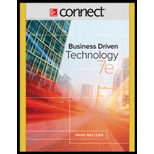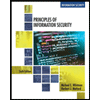
Connect with LearnSmart Access Card for Business Driven Technology
7th Edition
ISBN: 9781259852183
Author: Paige Baltzan, Amy Phillips
Publisher: McGraw-Hill Education
expand_more
expand_more
format_list_bulleted
Concept explainers
Expert Solution & Answer
Chapter 19, Problem 2CCT
Explanation of Solution
- a. Systems development life cycle (SDLC):
- The seven phases in SDLC includes:
- Planning phase
- The planning phase includes creating a goal statement for project.
- It defines a high level plan for intended project.
- It sets scope of project.
- The project plan denotes a formal, approved document that would manage and control entire project.
- A project manager creates a project plan and ensures that project finishes within given deadline and budget.
- Analysis Phase
- In analysis phase the firm would analyze business requirements.
- It refines goals of project into defined operations and functions of intended systems.
- The business requirements denote specific business requests made by system so as to successfully complete project.
- The requirements management denotes process of managing variations to requirements in business.
- A requirements definition document would prioritize all business requirements based on importance order.
- Design phase
- The design phase creates description for system features and operations.
- It includes following items:
- Screen layout
- Business rules
- Process diagrams
- Pseudo code
- The graphical user interface (GUI) denotes an
information system interface.
- Development phase
- The development phase transforms detailed design documents into actual system.
- During this phase, the team defines programming language for development.
- A scripting language may provide interactive modules to website.
- Object oriented languages may group data into objects.
- Testing phase
- The testing phase keeps all project modules under testing environment for elimination of bugs and errors.
- It verifies that system meets all requirements mentioned in analysis phase.
- Bugs denote defects in information system code.
- The test conditions denote steps that must be performed and expected result for each step.
- Implementation phase
- The system is placed into production, detailed documentation is performed.
- The users begin actual operations in business within system.
- Maintenance phase
- The organization performs corrections, changes and up gradations to ensure that system meets requirements.
- Corrective maintenance would make system changes to flaws in design, errors in coding or issues in implementation.
- Preventive maintenance would make system changes to reduce chances for system failure in future.
- Planning phase
- The planning phase includes creating a goal statement for project.
- It defines a high level plan for intended project.
- It sets scope of project.
- The project plan denotes a formal, approved document that would manage and control entire project.
- A project manager creates a project plan and ensures that project finishes within given deadline and budget.
- Analysis Phase
- In analysis phase the firm would analyze business requirements.
- It refines goals of project into defined operations and functions of intended systems.
- The business requirements denote specific business requests made by system so as to successfully complete project.
- The requirements management denotes process of managing variations to requirements in business.
- A requirements definition document would prioritize all business requirements based on importance order.
- Design phase
- The design phase creates description for system features and operations.
- It includes following items:
- Screen layout
- Business rules
- Process diagrams
- Pseudo code
- The graphical user interface (GUI) denotes an
information system interface.
- Development phase
- The development phase transforms detailed design documents into actual system.
- During this phase, the team defines programming language for development.
- A scripting language may provide interactive modules to website.
- Object oriented languages may group data into objects.
- Testing phase
- The testing phase keeps all project modules under testing environment for elimination of bugs and errors.
- It verifies that system meets all requirements mentioned in analysis phase.
- Bugs denote defects in information system code.
- The test conditions denote steps that must be performed and expected result for each step.
- Implementation phase
- The system is placed into production, detailed documentation is performed.
- The users begin actual operations in business within system.
- Maintenance phase
- The organization performs corrections, changes and up gradations to ensure that system meets requirements.
- Corrective maintenance would make system changes to flaws in design, errors in coding or issues in implementation.
- Preventive maintenance would make system changes to reduce chances for system failure in future.
Most important phase:
- All phases in SDLC are likewise important. No phase can be skipped...
Expert Solution & Answer
Want to see the full answer?
Check out a sample textbook solution
Students have asked these similar questions
This Question related to the subject Database
Keeping in view the concept of Software Development Life Cycle (SDLC), you are advised to extract/describe the following information:
a) Identify strategic planning factors?
b) Describe the functional system requirement specifications?
c) Select the appropriate language / tool for the development of the given below system and reason for the selection of language?
d) Write down the suitable steps for the development of working Prototype?
System Description:
Red Ice project comprises of an e-commerce website and an android app based on augmented reality. The theme behind this project is to give maximum satisfaction to the online customers about the products by showing a model in augmented reality before buying. This app will let the customers to visualize their desired product just in-front of them by using their smart phones. Let’s suppose you want to buy a table from online store, you have plenty…
1. Differentiate between generic software product development and custom software development by distinguishing the usage, reason of development, software owner, the software specification, and the decision of change. Support your answer with an example.
2. Demonstrate the Differentiating between Agile and the plan-driven development.
3. Demonstrate the structure of the Waterfall development model by explaining each phase of it with help of an example and discuss its properties and application.
4. What are the fundamentals of the software engineering activities?
5. Read carefully and understand the below scenario to solve the questions below :
Pizza restaurant looking for developing a mobile application that the customer can order Pizza online. The new customer has to sign-up to the application by providing his/her personal information (name, suggested username and password, phone number, and address). To place an order, the customer has to log in, provide the number of Pizza needed,…
For the Professional and Scientific Staff Management (PSSM) case, answer the following questions:
Q1. Are there any constraints about this project that need to be identified?
Q2. What software development methodology do you recommend for the case above? Why?
Q3. Add to the list of requirements based on what you have read and your research in the area. Please also add your sources at the bottom, so I can learn.
Chapter 19 Solutions
Connect with LearnSmart Access Card for Business Driven Technology
Ch. 19 - What are the three interdependent variables...Ch. 19 - Prob. 2OCCh. 19 - Prob. 3OCCh. 19 - Prob. 1CQCh. 19 - Prob. 2CQCh. 19 - How could more time spent in the analysis and...Ch. 19 - Prob. 4CQCh. 19 - Prob. 1RQCh. 19 - Prob. 2RQCh. 19 - Prob. 3RQ
Ch. 19 - Prob. 4RQCh. 19 - Prob. 5RQCh. 19 - Prob. 6RQCh. 19 - Prob. 7RQCh. 19 - Prob. 8RQCh. 19 - Prob. 9RQCh. 19 - Prob. 1MBDCh. 19 - Prob. 2MBDCh. 19 - Prob. 3MBDCh. 19 - Prob. 4MBDCh. 19 - Prob. 5MBDCh. 19 - Prob. 6MBDCh. 19 - Prob. 1CCOCh. 19 - Prob. 2CCOCh. 19 - Prob. 3CCOCh. 19 - Prob. 4CCOCh. 19 - Prob. 5CCOCh. 19 - Prob. 1CCTCh. 19 - Prob. 2CCTCh. 19 - Prob. 3CCTCh. 19 - Prob. 4CCTCh. 19 - Prob. 5CCTCh. 19 - Prob. 1AYKCh. 19 - Prob. 2AYKCh. 19 - Prob. 3AYKCh. 19 - Prob. 4AYKCh. 19 - Prob. 5AYKCh. 19 - Prob. 6AYKCh. 19 - Prob. 7AYK
Knowledge Booster
Learn more about
Need a deep-dive on the concept behind this application? Look no further. Learn more about this topic, computer-science and related others by exploring similar questions and additional content below.Similar questions
- 1. Discuss and plan 1 software project to develop. a) Based on the chosen Software Project, define: i. Background and introduction ii. Aim and Objectives iii. Problem Statements and Scopes. iv. Choose 1 life cycle to use and explain why. v. Create Sphere Model. (Business, organization, technology) (minimum 3 questions and answer for each of the element in the sphere.arrow_forwardExplain Lean Development and consider two scenarios from your study routine of Advance Software Engineering where you can apply lean strategy it can be any activity related to your Advance software engineering course i.e study, prepare for exam or exam conduction. Description(Max 15 words) Identify Waste 1 Waste 1 Mitigation steps Handover 1 after completion What you achieved after Lean Strategy Handover 1 Identify Waste 2 Waste 2 Mitigation steps Handover 2 after completion What you achieved after Lean Strategy after Handover 2arrow_forwardThis is a software engineering question I am stuck on. Which of the below statements describe a quality culture? Select one or more: 1. Teams take responsibility for the quality of their work and develop new approaches to quality improvement 2. Employees that are offered incentives always produce high-quality software products. 3. Software quality is guaranteed by a systematic and structured process with clear deliverables and carefully designed management activities 4. Quality management is more about optimising potentially conflicting requirements than it is about ensuring software meets its specifications. 5. It is the primary responsibility of the product owner to ensure that software development team are committed to achieving a high level of product quality 6. Recruitment is carefully focused to ensure only the most high-quality software developers become part of the team, ensuring software quality automaticallyarrow_forward
- You'll be expected to advise your client on the best method for gathering requirements as a software engineer.In order to meet the requirements, your client will allow your personnel to observe their everyday activities within the clinic.Please describe TWO (2) techniques that you believe your team should use in this demand elicitation process, along with your reasoning.arrow_forwardKeeping in view the concept of Software Development Life Cycle (SDLC), you are advised to extract/describe the following information: a) Identify strategic planning factors? b) Describe the functional system requirement specifications? c) Select the appropriate language / tool for the development of the given below system and reason for the selection of language? d) Write down the suitable steps for the development of working Prototype? System Description: Red Ice project comprises of an e-commerce website and an android app based on augmented reality. The theme behind this project is to give maximum satisfaction to the online customers about the products by showing a model in augmented reality before buying. This app will let the customers to visualize their desired product just in-front of them by using their smart phones. Let’s suppose you want to buy a table from online store, you have plenty of options available and you have no idea…arrow_forwardYou and your team have been hired to perform a system investigation for a fast food restaurant that wants to implement new tools and processes to improve its customer service. Currently, the restaurant has a poor reputation for not correctly filling customers orders and for taking too long to do it. Perform a functional decomposition to define the scope and basic requirements of such a system. Brainstorm some ideas to improve the situation, and choose one to pursue based on its technical, economic, legal, operational, and schedule feasibility.arrow_forward
- Identify an information system frequently employed by people in a career field you are interested in. Discuss how you might be involved as a user in the development or acquisition of such a system for your future company. Identify three things that you could do as a project participant that would greatly improve the likelihood of a successful project. Now, identify three things that you could do (or fail to do) that could greatly diminish the probability of success of such a project.arrow_forwardSearch the Internet for two interesting articles about software development life cycles, including agile development. Review the website www.agilealliance.org. What do these sources say about project management? Write a summary of your findings and opinions on this topic, and cite your references.arrow_forwardList and describe the three major steps in executing the project plan.arrow_forward
- Who is the best judge of effort estimates for project tasks and action steps? Why?arrow_forwardReview the sample documents provided for JWD Consulting to answer the following questions. What was the success criteria for this project? What was the estimated discounted life cycle ROI? Describe three key product-related deliverables. What were the top three risks? Did the project meet scope, time, and cost goals? When were the shippable products completed using the predictive approach and agile approach?arrow_forward
arrow_back_ios
arrow_forward_ios
Recommended textbooks for you
 Information Technology Project ManagementComputer ScienceISBN:9781337101356Author:Kathy SchwalbePublisher:Cengage Learning
Information Technology Project ManagementComputer ScienceISBN:9781337101356Author:Kathy SchwalbePublisher:Cengage Learning Fundamentals of Information SystemsComputer ScienceISBN:9781305082168Author:Ralph Stair, George ReynoldsPublisher:Cengage Learning
Fundamentals of Information SystemsComputer ScienceISBN:9781305082168Author:Ralph Stair, George ReynoldsPublisher:Cengage Learning Principles of Information Systems (MindTap Course...Computer ScienceISBN:9781305971776Author:Ralph Stair, George ReynoldsPublisher:Cengage Learning
Principles of Information Systems (MindTap Course...Computer ScienceISBN:9781305971776Author:Ralph Stair, George ReynoldsPublisher:Cengage Learning Fundamentals of Information SystemsComputer ScienceISBN:9781337097536Author:Ralph Stair, George ReynoldsPublisher:Cengage Learning
Fundamentals of Information SystemsComputer ScienceISBN:9781337097536Author:Ralph Stair, George ReynoldsPublisher:Cengage Learning Principles of Information Security (MindTap Cours...Computer ScienceISBN:9781337102063Author:Michael E. Whitman, Herbert J. MattordPublisher:Cengage Learning
Principles of Information Security (MindTap Cours...Computer ScienceISBN:9781337102063Author:Michael E. Whitman, Herbert J. MattordPublisher:Cengage Learning Database Systems: Design, Implementation, & Manag...Computer ScienceISBN:9781285196145Author:Steven, Steven Morris, Carlos Coronel, Carlos, Coronel, Carlos; Morris, Carlos Coronel and Steven Morris, Carlos Coronel; Steven Morris, Steven Morris; Carlos CoronelPublisher:Cengage Learning
Database Systems: Design, Implementation, & Manag...Computer ScienceISBN:9781285196145Author:Steven, Steven Morris, Carlos Coronel, Carlos, Coronel, Carlos; Morris, Carlos Coronel and Steven Morris, Carlos Coronel; Steven Morris, Steven Morris; Carlos CoronelPublisher:Cengage Learning

Information Technology Project Management
Computer Science
ISBN:9781337101356
Author:Kathy Schwalbe
Publisher:Cengage Learning

Fundamentals of Information Systems
Computer Science
ISBN:9781305082168
Author:Ralph Stair, George Reynolds
Publisher:Cengage Learning

Principles of Information Systems (MindTap Course...
Computer Science
ISBN:9781305971776
Author:Ralph Stair, George Reynolds
Publisher:Cengage Learning

Fundamentals of Information Systems
Computer Science
ISBN:9781337097536
Author:Ralph Stair, George Reynolds
Publisher:Cengage Learning

Principles of Information Security (MindTap Cours...
Computer Science
ISBN:9781337102063
Author:Michael E. Whitman, Herbert J. Mattord
Publisher:Cengage Learning

Database Systems: Design, Implementation, & Manag...
Computer Science
ISBN:9781285196145
Author:Steven, Steven Morris, Carlos Coronel, Carlos, Coronel, Carlos; Morris, Carlos Coronel and Steven Morris, Carlos Coronel; Steven Morris, Steven Morris; Carlos Coronel
Publisher:Cengage Learning